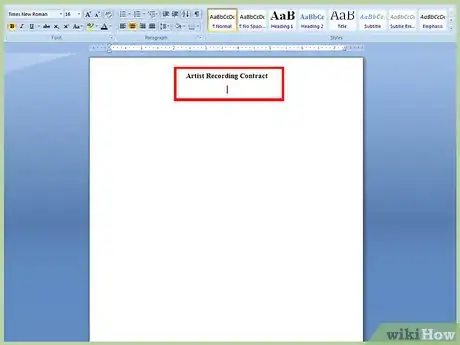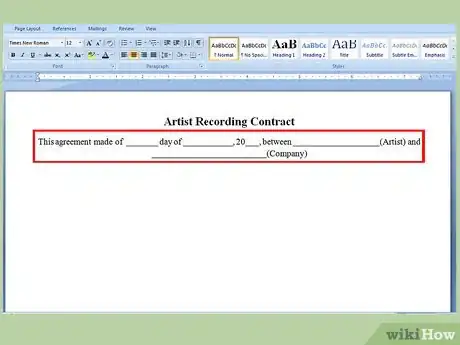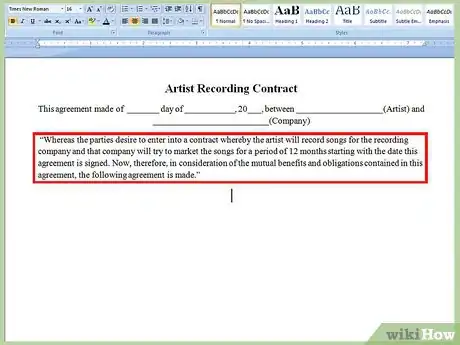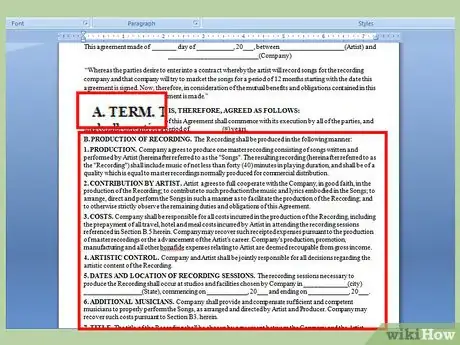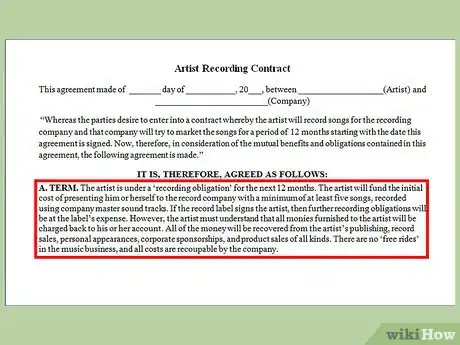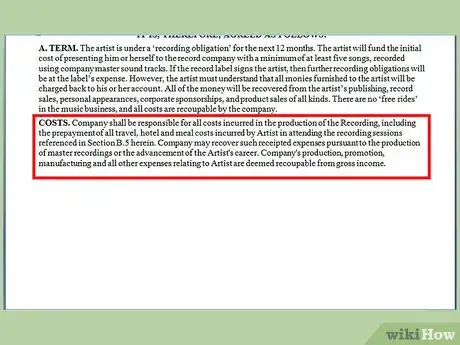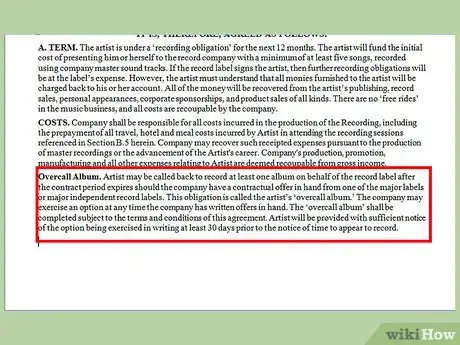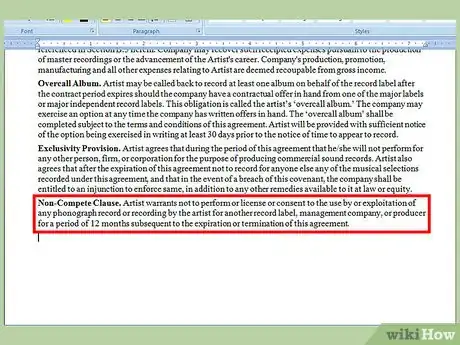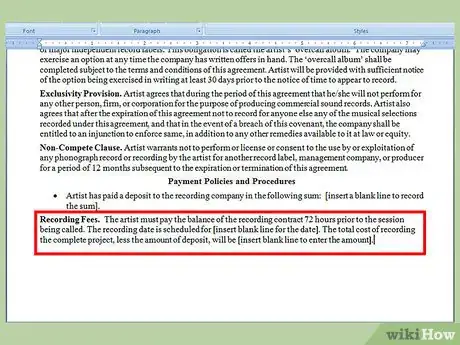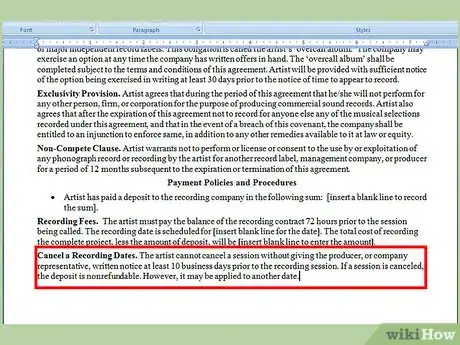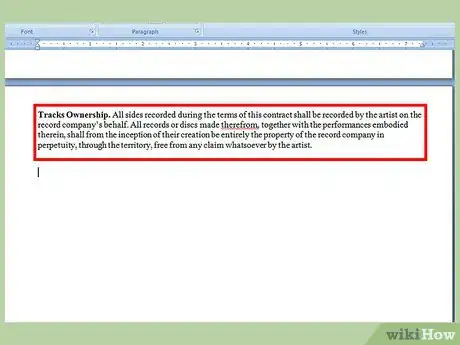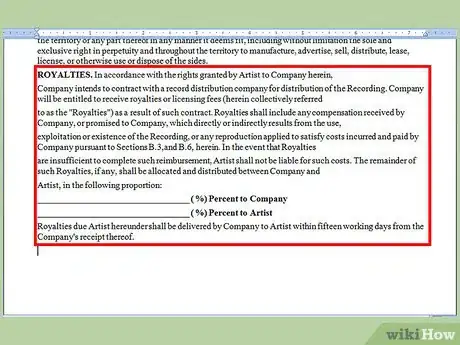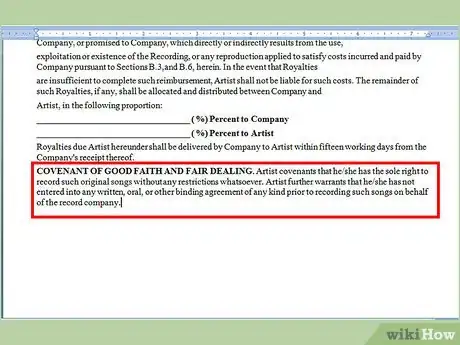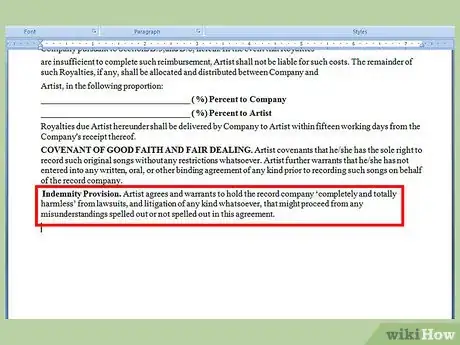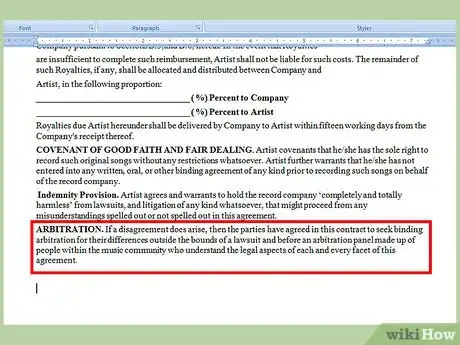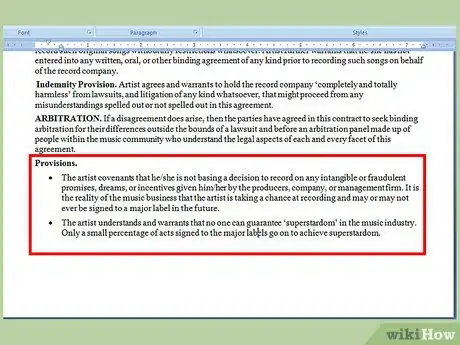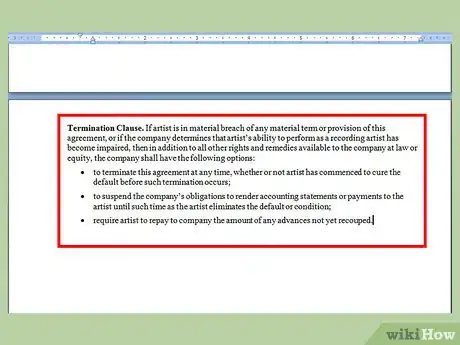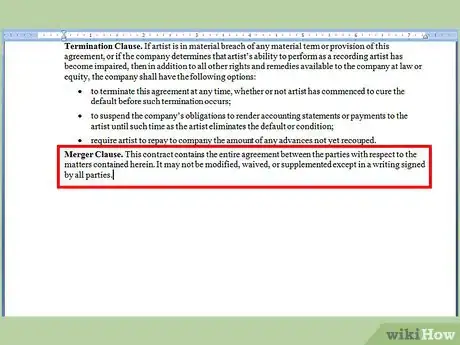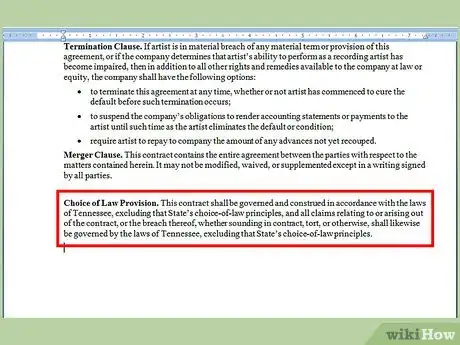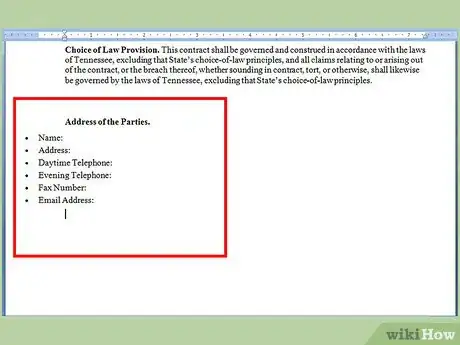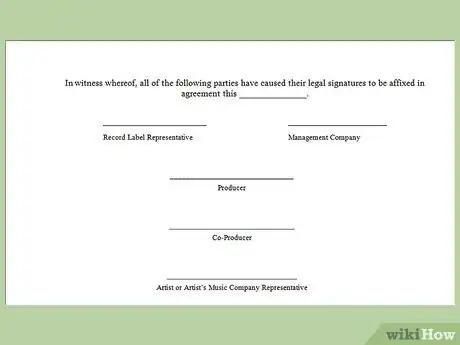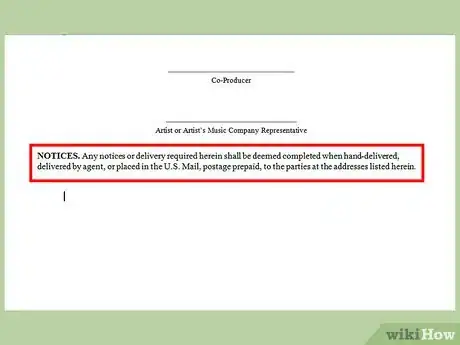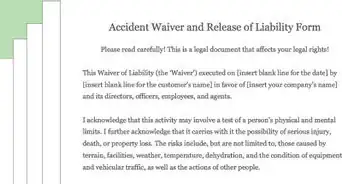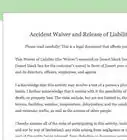This article was co-authored by Clinton M. Sandvick, JD, PhD. Clinton M. Sandvick worked as a civil litigator in California for over 7 years. He received his JD from the University of Wisconsin-Madison in 1998 and his PhD in American History from the University of Oregon in 2013.
There are 7 references cited in this article, which can be found at the bottom of the page.
This article has been viewed 30,563 times.
A recording contract is an agreement between a record label and an artist. The contract identifies the artist’s recording obligations and explains how the record label will market and distribute copies. The contract also explains how royalties are calculated for each sale. Recording contracts are usually drafted by the record label, though an artist should have a general sense of what is in one. In order to make sure that the recording contract is complete, the drafter should show it to a qualified attorney.
Steps
Recording Contract Template
Beginning the Contract
-
1Format the document. You want the contract to be easy to read, so make sure that you set the font to a comfortable size and style. Times New Roman 12 point is fairly standard.
- You can also play around with bold and larger font sizes if you want to emphasize certain portions of the contract.
-
2Add the title. At the top of the first page, you should center “Artist Recording Contract” between the right- and left-hand margins.[1] You can make the title a little larger than the rest of the type.Advertisement
-
3Identify the parties to the contract. At the beginning, you should identify the artist and the recording company. You should create the contract as a template that can be used more than once. To do so, you should insert blank lines for the date and the artist’s name.
- Sample language could read, “This agreement made of [insert blank line for the date] between [insert your name] (‘company,’ ‘Record Label,’ or ‘Recording Company’) and [insert blank line for artist name] (‘artist’).”[2]
-
4Insert your recitals. Recitals are the “whereas” clauses that describe the general nature or background of the contract.[3] You will want to include recitals that describe the desires of each party. It is standard for recitals to be fragment sentences.
- You could write: “Whereas the parties desire to enter into a contract whereby the artist will record songs for the recording company and that company will try to market the songs for a period of 12 months starting with the date this agreement is signed. Now, therefore, in consideration of the mutual benefits and obligations contained in this agreement, the following agreement is made.”[4]
-
5Include a definition section. The contract might contain terms you need to define because they would not be understood by the average person. If you end up in court in a contract lawsuit, you will want the judge to understand how you are using terms. Accordingly, you should define any terms you don’t think are clear.
- One term you will definitely need to define is “territory.” The record label gets rights to only certain territories. When signing a new artist, the label usually defines the “territory” as the entire world.[5] More established artists will try to get separate contracts for different territories, such as North America.
- You might want to save this step for last. Once you finish a draft of the contract, you can then go back through it and identify unclear terms.
Inserting the Contract Terms
-
1Clarify the artist’s recording obligations. An artist needs to present you with some songs before you agree to market him or her. Accordingly, you should explain the initial recording obligation. For example, a recording company might require that the artist cut a minimum of five songs using the company’s master sound tracks. You should explain how the costs of recording these songs will be charged back to the artist.
- For example, you could write, “The artist is under a ‘recording obligation’ for the next 12 months. The artist will fund the initial cost of presenting him or herself to the record company with a minimum of at least five songs, recorded using company master sound tracks. If the record label signs the artist, then further recording obligations will be at the label’s expense. However, the artist must understand that all monies furnished to the artist will be charged back to his or her account. All of the money will be recovered from the artist’s publishing, record sales, personal appearances, corporate sponsorships, and product sales of all kinds. There are no ‘free rides’ in the music business, and all costs are recoupable by the company.”[6]
-
2Identify costs which will not be charged back. You might not charge back all expenses to the artist. If not, then identify those costs which you won’t charge back. For example, you might not charge for the following:
- manufacture of the single record on compact disc
- mailing, labor, and postage related to mailing the single to all radio reporter stations
- service and re-service costs
- in-house label promotion
-
3Include an “overcall album” provision. You might get a deal for an album from one of the major labels or major independent record labels during the 12-month term of the contract. However, the contract might have expired before you can record it. You should include a provision where the artist agrees to come back and record the album in this situation.
- For example, you could write: “Artist may be called back to record at least one album on behalf of the record label after the contract period expires should the company have a contractual offer in hand from one of the major labels or major independent record labels. This obligation is called the artist’s ‘overcall album.’ The company may exercise an option at any time the company has written offers in hand. The ‘overcall album’ shall be completed subject to the terms and conditions of this agreement. Artist will be provided with sufficient notice of the option being exercised in writing at least 30 days prior to the notice of time to appear to record.”[7]
-
4Add an exclusivity provision. During the term of the contract, you don’t want the artist recording or performing for anyone else. For this reason, you should include a term where the artist agrees to be exclusive to your recording company.
- Use a clause like this: “Artist agrees that during the period of this agreement that he/she will not perform for any other person, firm, or corporation for the purpose of producing commercial sound records. Artist also agrees that after the expiration of this agreement not to record for anyone else any of the musical selections recorded under this agreement, and that in the event of a breach of this covenant, the company shall be entitled to an injunction to enforce same, in addition to any other remedies available to it at law or equity.”[8]
-
5Add a non-compete clause. Legally, you can get the artist to agree not to record a contract or promote a recording for another label for a certain amount of time after your contract ends. You should expect the artist to push back on this, but you can include it in your template:
- “Artist warrants not to perform or license or consent to the use by or exploitation of any phonograph record or recording by the artist for another record label, management company, or producer for a period of 12 months subsequent to the expiration or termination of this agreement.”[9]
Describing Payment Policies and Procedures
-
1Identify any deposit the artist paid. The artist or the artist’s music company will probably pay you a deposit in order to record the initial tracks. You should identify the amount of the deposit in this section.
- For example, you could state, “Artist has paid a deposit to the recording company in the following sum: [insert a blank line to record the sum].”[10]
- You can also identify the method used (such as wire transfer, certified check, etc.) and where the money was sent (i.e., the name of your bank).
-
2Explain how the artist will pay the balance of the recording fees. The artist needs to pay the remainder of the costs for recording before you will begin a recording session. You should explain the details.
- For example, you could write: “The artist must pay the balance of the recording contract 72 hours prior to the session being called. The recording date is scheduled for [insert blank line for the date]. The total cost of recording the complete project, less the amount of deposit, will be [insert blank line to enter the amount].”[11]
-
3Explain how the artist can cancel a recording date. You want to spell out clearly whether the artist can get a refund on their deposit or fees if they need to cancel a recording session. For example, you might write:
- “The artist cannot cancel a session without giving the producer, or company representative, written notice at least 10 business days prior to the recording session. If a session is canceled, the deposit is nonrefundable. However, it may be applied to another date.”[12]
-
4Explain who owns the tracks recorded. To prevent disputes from arising after recording, you should explain who will own the recorded tracks. It is standard for the record label to hold all rights to the music when the artist is a novice. More established artists can negotiate to gain control of the music after a certain amount of time.
- You could write, “All sides recorded during the terms of this contract shall be recorded by the artist on the record company’s behalf. All records or discs made therefrom, together with the performances embodied therein, shall from the inception of their creation be entirely the property of the record company in perpetuity, through the territory, free from any claim whatsoever by the artist.”[13]
-
5Identify your distribution rights. You should also explain in the contract that you have the sole rights to use the recorded songs throughout the territory you agreed to, as you see fit. With this clause, you are basically telling the artist that you will control distribution, not the artist.
- For example, you could include this distribution provision: “The record company shall have the sole and exclusive right to use the sides throughout the territory or any part thereof in any manner it deems fit, including without limitation the sole and exclusive right in perpetuity and throughout the territory to manufacture, advertise, sell, distribute, lease, license, or otherwise use or dispose of the sides.”[14]
-
6Identify the royalty rate. The artist will expect a certain percentage of the sale of each CD or digital downloads. You need to include provisions which address how royalties are paid. Be sure to include information about domestic royalties and international royalties.[15]
- Most recording labels pay a lesser royalty amount on international sales than they do on domestic sales. If the artist has a lawyer, then you should expect to negotiate the royalty rate.[16]
- To understand what is a standard royalty rate, contact other record labels or meet with an experienced lawyer in the music industry.
Adding Covenants
-
1Include a covenant that the artist’s work is original. You want to protect yourself from an artist who steals another person’s work but presents it to you as original. In that situation, you could be sued for copyright infringement.
- For example, you could include this covenant: “Artist covenants that he/she has the sole right to record such original songs without any restrictions whatsoever. Artist further warrants that he/she has not entered into any written, oral, or other binding agreement of any kind prior to recording such songs on behalf of the record company.”[17]
-
2Add an indemnity provision. By agreeing to this provision, the artist agrees not to sue you for any misunderstandings in the agreement. Obviously, including this provision won’t entirely prevent lawsuits. However, it can be helpful to have.
- You might write: “Artist agrees and warrants to hold the record company ‘completely and totally harmless’ from lawsuits, and litigation of any kind whatsoever, that might proceed from any misunderstandings spelled out or not spelled out in this agreement.”[18]
-
3Insert a dispute resolution clause. You can agree to arbitrate any disputes that arise under this contract. Arbitration is like a trial except it is private. You present your case to an arbitrator instead of a judge. Alternately, you could include a provision that you will mediate any dispute with the help of a mediator.
- “If a disagreement does arise, then the parties have agreed in this contract to seek binding arbitration for their differences outside the bounds of a lawsuit and before an arbitration panel made up of people within the music community who understand the legal aspects of each and every facet of this agreement.”[19]
-
4Include provisions that explain the music industry is risky. Many young artists have stars in their eyes and imagine that fame and wealth are automatically guaranteed because they have signed a recording contract. You can include some provisions which explain to the artist that the music industry is risky.
- For example, you could have the artist promise to the following: “The artist covenants that he/she is not basing a decision to record on any intangible or fraudulent promises, dreams, or incentives given him/her by the producers, company, or management firm. It is the reality of the music business that the artist is taking a chance at recording and may or may not ever be signed to a major label in the future.”
- Also, you can have the artist warrant that no one is guaranteed success: “The artist understands and warrants that no one can guarantee ‘superstardom’ in the music industry. Only a small percentage of acts signed to the major labels go on to achieve superstardom.”[20]
- For extra emphasis, you can set these provisions off in bold type.
Finalizing the Contract
-
1Include a termination clause. Near the end of the contract, you want to explain how the contract can be terminated and what grounds can trigger termination. Generally, you will want to give yourself the power to terminate the agreement if the artist breaks any provision in the contract.
- For example, you could write: “If artist is in material breach of any material term or provision of this agreement, or if the company determines that artist’s ability to perform as a recording artist has become impaired, then in addition to all other rights and remedies available to the company at law or equity, the company shall have the following options: (1) to terminate this agreement at any time, whether or not artist has commenced to cure the default before such termination occurs; (2) to suspend the company’s obligations to render accounting statements or payments to the artist until such time as the artist eliminates the default or condition; and/or (3) require artist to repay to company the amount of any advances not yet recouped.”
-
2Add a merger clause. This clause states that the contract contains the entirety of your agreement. Any prior agreements are merged (and superseded) by the written agreement. You want this clause so that the artist doesn’t sue and claim that you had a prior oral agreement that isn’t included in the contract.
- A sample merger clause might read: “This contract contains the entire agreement between the parties with respect to the matters contained herein. It may not be modified, waived, or supplemented except in a writing signed by all parties.”[21]
-
3Insert a choice of law provision. If you find yourself in a contract dispute, then the judge will have to interpret the contract using a state’s law. You can decide which state’s law you want to use. Generally, companies pick the law of the state where they are located.
- A choice of law provision could read: “This contract shall be governed and construed in accordance with the laws of Tennessee, excluding that State’s choice-of-law principles, and all claims relating to or arising out of the contract, or the breach thereof, whether sounding in contract, tort, or otherwise, shall likewise be governed by the laws of Tennessee, excluding that State’s choice-of-law principles.”[22]
-
4Include the address of the parties. You should clearly lay out each party’s address. Don’t put this information under the signature blocks. Instead, you can insert it before the signatures. Make sure that you have the following information for each party:
- name
- address
- daytime telephone
- evening telephone
- fax number
- email address
-
5Include signature lines. It is common for many different people to sign a recording contract, so you will probably need five signature lines. Just above the lines, include the following: “In witness whereof, all of the following parties have caused their legal signatures to be affixed in agreement this [insert blank line for the date].” You should have a signature line for each of the following people:[23]
- Record Label Representative
- Management Company
- Producer
- Co-Producer
- Artist or Artist’s Music Company Representative
-
6Add a notary block. The contract may be signed in front of a notary public. If you want the contract notarized, then include a notary block. You can find an appropriate block for your state by searching the Internet.
-
7Show the contract to your lawyer. This is only a basic recording contract. After you have completed a draft, you should show the contract to your lawyer. He or she will look it over and tell you if you need to include anything else. Contracts usually have to be modified according to your particular business needs.
- If you don’t have a lawyer, then ask other recording companies who their attorney is and whether they would recommend their attorney. You can then call the lawyer and schedule a consultation. Take your sample contract with you.
-
8Give the draft contract to the artist. You can negotiate the terms of the contract. Let the artist and the artist’s lawyer (if there is one) look over the contract. They may write comments on the draft and send this draft back to you.[24]
- Your lawyers may have to talk with each other to negotiate compromises on some issues. Make sure that each side agrees to the entire contract before signing it.
-
9Distribute copies of the signed agreement. After everyone has signed the agreement, you should make at least one copy for each person who signed it. Also keep the original in a safe place, such as a safety deposit box.
References
- ↑ http://www.americanbar.org/content/dam/aba/migrated/2011_build/entertainment_sports/artist_recording_contract.authcheckdam.pdf
- ↑ http://www.americanbar.org/content/dam/aba/migrated/2011_build/entertainment_sports/artist_recording_contract.authcheckdam.pdf
- ↑ http://definitions.uslegal.com/r/recitals/
- ↑ http://www.americanbar.org/content/dam/aba/migrated/2011_build/entertainment_sports/artist_recording_contract.authcheckdam.pdf
- ↑ https://www.soundonsound.com/sos/apr07/articles/contracts.htm
- ↑ http://www.americanbar.org/content/dam/aba/migrated/2011_build/entertainment_sports/artist_recording_contract.authcheckdam.pdf
- ↑ http://www.americanbar.org/content/dam/aba/migrated/2011_build/entertainment_sports/artist_recording_contract.authcheckdam.pdf
- ↑ http://hiphopproduction.com/contracts/pdf/recording_contractartist.pdf
- ↑ http://www.americanbar.org/content/dam/aba/migrated/2011_build/entertainment_sports/artist_recording_contract.authcheckdam.pdf
- ↑ http://www.americanbar.org/content/dam/aba/migrated/2011_build/entertainment_sports/artist_recording_contract.authcheckdam.pdf
- ↑ http://www.americanbar.org/content/dam/aba/migrated/2011_build/entertainment_sports/artist_recording_contract.authcheckdam.pdf
- ↑ http://www.americanbar.org/content/dam/aba/migrated/2011_build/entertainment_sports/artist_recording_contract.authcheckdam.pdf
- ↑ http://www.americanbar.org/content/dam/aba/migrated/2011_build/entertainment_sports/artist_recording_contract.authcheckdam.pdf
- ↑ http://www.americanbar.org/content/dam/aba/migrated/2011_build/entertainment_sports/artist_recording_contract.authcheckdam.pdf
- ↑ http://www.americanbar.org/content/dam/aba/migrated/2011_build/entertainment_sports/artist_recording_contract.authcheckdam.pdf
- ↑ http://blog.buko.net/legal/management-and-recording/recording-contracts-the-basic-concepts/
- ↑ http://www.americanbar.org/content/dam/aba/migrated/2011_build/entertainment_sports/artist_recording_contract.authcheckdam.pdf
- ↑ http://www.americanbar.org/content/dam/aba/migrated/2011_build/entertainment_sports/artist_recording_contract.authcheckdam.pdf
- ↑ http://www.americanbar.org/content/dam/aba/migrated/2011_build/entertainment_sports/artist_recording_contract.authcheckdam.pdf
- ↑ http://www.americanbar.org/content/dam/aba/migrated/2011_build/entertainment_sports/artist_recording_contract.authcheckdam.pdf
- ↑ http://www.americanbar.org/content/dam/aba/migrated/2011_build/entertainment_sports/artist_recording_contract.authcheckdam.pdf
- ↑ http://www.lexology.com/library/detail.aspx?g=19184c3b-3d68-427a-87f5-c7e3ef3e60f5
- ↑ http://www.americanbar.org/content/dam/aba/migrated/2011_build/entertainment_sports/artist_recording_contract.authcheckdam.pdf
- ↑ http://blog.buko.net/legal/management-and-recording/recording-contracts-the-basic-concepts/


